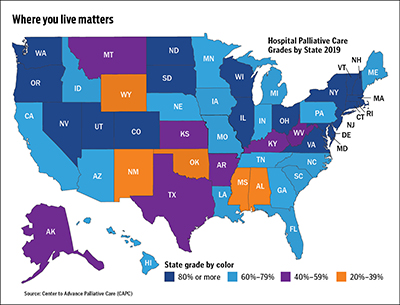Palliative care map shows that where patients live determines access to supportive care
By LISA EISENHAUER
When it comes to palliative care, Catholic hospitals continue to lead the way, according to the Center to Advance Palliative Care.
The center recently released a report, "America's Care of Serious Illness: 2019 State-by-State Report Card on Access to Palliative Care In Our Nation's Hospitals," that looked at nonfederal hospitals with 50 or more beds. Of those, the center found that 91 percent of Catholic hospitals offer palliative care, compared to 72 percent of hospitals overall.

Meier
"The Catholic hospitals have been way ahead of the rest of the hospitals since we started measuring and remain there," Dr. Diane E. Meier, the center's director, said at the release of the report in early October. She summarized the report and took questions in a web broadcast from Capitol Hill. The center, part of the Icahn School of Medicine at Mount Sinai in New York City, has issued "report cards" on palliative care in the U.S. every four years since 2001. Meier, a professor of geriatrics and palliative care medicine at the Icahn School, helped shape the field of palliative care and she has championed its adoption by hospitals and providers to address the physical and psychological suffering of patients at every stage of serious chronic illness.
The report found much improvement since 2001 when only 7 percent of hospitals had programs to provide team-based palliative care to people with serious illness. In 2019, almost three in four do. The outliers are largely for-profit, with only 35 percent of that sector providing palliative care, and rural hospitals, with only 17 percent offering such care, according to the report.
While patients living in Northeastern states are likely to have ready access to hospitals with palliative care services, patients living in South Central states may have a much harder time accessing palliative care. For instance, the report found that fewer than one in three hospitals in Alabama and Mississippi have palliative care teams.
 "This geographic limitation in access is not limited to palliative care," Meier said. "It's true of many other aspects of access to health care that geography is destiny, that where you live largely determines what care you have access to."
"This geographic limitation in access is not limited to palliative care," Meier said. "It's true of many other aspects of access to health care that geography is destiny, that where you live largely determines what care you have access to."
Meier said there is a growing body of evidence that, in addition to improving the quality of life of patients with chronic disease, palliative care lowers health care costs, "so it is the exemplar of high-value medical intervention."
Since the report was last released in 2015, the percentage of hospitals with palliative care programs has climbed to 72 percent from 66 percent.
Meier sees hopeful signs for continued expansion of access to palliative care. For one thing, a change in federal rules has opened the door to coverage of home-based palliative care by Medicare Advantage providers. In addition, Sens. Jacky Rosen, D-Nev.; John Barrasso, R-Wyo.; Deb Fischer, R-Neb.; and Tammy Baldwin, D-Wis., formed the Comprehensive Care Caucus this summer and pledged to raise awareness of, promote access to and improve the quality of palliative and coordinated care.
Meier is optimistic that the caucus and others will address what the Center to Advance Palliative Care sees as gaps, such as too few palliative care specialists being trained, inadequate fee-for-service payments from insurers and a lack of meaningful measures of quality care.
For inspiration on how to get palliative care to more of the 12 million adults and 400,000 children living with a serious illness, such as cancer, heart disease, kidney disease, or dementia, Meier said policymakers could look to states like California, which recently made it legal for licensed hospices to provide palliative care to non-hospice patients, or Maryland, which passed a law requiring hospitals with over 50 beds to establish programs that meet quality criteria.
To offer tips on how to leverage the report's findings and recommendations, the center started a blog called Palliative in Practice. It launched in October at capc.org/blog/.
"How do we make progress toward a world where when you go to the hospital you can assume that a reasonably high-quality palliative care service is there?" Meier asked. "In order to get that done, we need policy change."
Best and worst states for palliative care access
Top five states for palliative care and their grades from the Center for Palliative Care
1. New Hampshire (A) 100.0% [tie]
1. Rhode Island (A) 100.0% [tie]
1. Vermont (A) 100.0% [tie]
1. Delaware (A) 100.0% [tie]
5. Connecticut (A) 95.8%
Bottom five states for palliative care
47. Alabama (D) 39.3%
48. New Mexico (D) 38.5%
49. Oklahoma (D) 37.5% [tie]
49. Wyoming (D) 37.5% [tie]
51. Mississippi (D) 33.3%